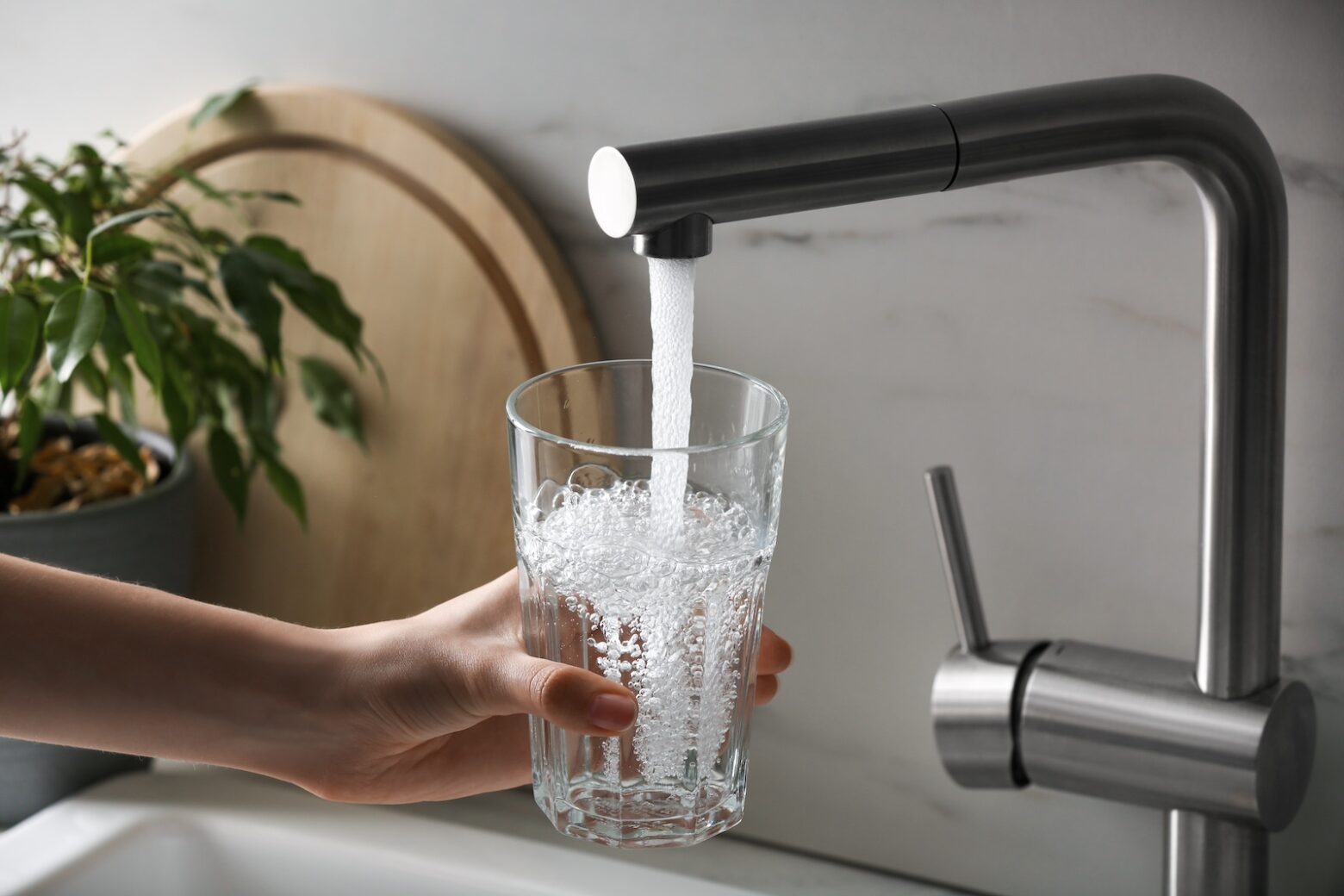Are PFAS in Tap Water Safe to Drink?

Many Americans use filtered and unfiltered water straight from the tap every single day. We bathe in it, cook with it, wash our hands and clothes with it, and brush our teeth with it. Sometimes, we drink it too. But how safe is tap water for drinking?
The quality of tap water depends on the location. In the United States, the water is filtered beforehand to be safe for consumption, but occasionally some facilities may violate water quality standards. Though most contaminants are usually filtered out in these facilities, substances like PFAS remain prevalent in tap water, and should be avoided.
PFAS
PFAS is an acronym for per- and polyfluoroalkyl substances, an umbrella term that includes thousands of different compounds. These were formerly referred to as perfluorinated chemicals (PFCs), though current nomenclature supports PFAS as the more accurate term. These human-made chemicals were designed to repel water, grease, and oil and have been used in consumer and industrial products since the 1940s. They can be found in items such as waterproof clothing and footwear, non-stick cookware, stain-resistant carpets and fabrics, surf and ski waxes, cosmetics, sunscreens, dental floss, microwave popcorn bags, fast food containers, greaseproof paper, candy wrappers, and pizza boxes. [1,2,3]
PFAS are often referred to as “forever chemicals” because of their resistance to breaking down in the human body and the environment. Since these chemicals have only been in use for around 75 years, it is not known exactly how long it will take for them to break down completely, or if they ever will. PFAS exposure in humans and animals has been linked to cancer, liver and thyroid problems, hormone disruption, abnormal fetal development, and interference with vaccine effectiveness. Even at extremely low concentrations (parts per quadrillion), PFAS are considered toxic to human health. [4]
PFAS Exposure Through Drinking Water
Recent water quality testing has revealed that 70 million people in the United States are exposed to PFAS through their public water supply. These substances have been found in public and private water supplies in all 50 states, the District of Columbia, and four U.S. territories. [5] This data is only representative of one-third of the total public water supplies in the United States, therefore the actual number of people drinking PFAS-contaminated water is expected to be much greater. [6] Even private well water supplies have tested positive for PFAS. [7]
In March 2023, the Environmental Protection Agency lowered the legal drinking water limit for six well-studied PFAS from 70 parts per trillion to 4 parts per trillion. While 70 to 4 seems like a significant leap, scientists argue that exposure to PFAS at any level is unsafe. [8] Additionally, this limit only applies to six PFAS. What about the other thousands? Considering it could take decades for public water suppliers to completely remove PFAS from water because of the lack of regulations and the persistent nature of PFAS themselves, consumers can protect themselves in the meantime by using a water filter.
Water Pollution Solutions
There are several home water filtration options to consider. They include whole-house systems, under-sink systems, and portable gravity or pitcher systems. The Environmental Working Group tested 10 portable water filters on their ability to remove PFAS, and only three of the filters were able to remove PFAS completely. Out of these three filters, the Travel Berkey system stood out as the best overall choice. Among the filters tested, it was the only filter that removed 100% of PFAS, has a non-plastic reservoir, and has a significantly lower overall lifetime cost thanks to the more than eight-year filter life.
When shopping for a filtration system, ask to see the company’s testing data regarding removal of PFAS and other contaminants like pesticides, pharmaceuticals, heavy metals, nitrate, nitrites, BPA, chlorine, fluoride, VOCs, viruses, parasites, and bacteria. Look for products that meet or exceed the NSF/ANSI 53 certification standard for water filters or the NSF/ANSI 58 certification for reverse osmosis systems.
Whole-house water softeners and iron filtration systems do not remove PFAS. Boiling water also does not remove PFAS. [9] It is important to consider that even though reverse osmosis systems have been shown to remove PFAS, they waste more water than they produce, remove beneficial minerals, and change the pH of the water from neutral to acidic. [10]
As of 2023, the EPA does not recommend bottled water as a solution to PFAS contamination. Once water is bottled, it is regulated by the FDA, not the EPA. The FDA has not yet established a legal limit for PFAS in bottled water and testing carried out in 2022 demonstrated PFAS contamination in some brands that exceeded the advisory levels set by the EPA. (4) Exposure to additional chemicals such as BPA and phthalates are also a risk when drinking from plastic bottles.
Protecting Against PFAS Exposure in the Future
Although the EPA is taking steps to protect consumers from PFAS, these “forever chemicals” will persist in our environment and our bodies without further regulation and complete elimination. Products containing PFAS need to be phased out urgently and completely.
In the meantime, consumers are not powerless. Increased demand for PFAS-free products has already motivated many brands to remove PFAS from their processes and materials. If you are unsure about a product, reach out to the manufacturer for confirmation. It is important to use the umbrella term PFAS, as other terms like PFOS (perfluorooctane sulfonic acid) and PFOA (perfluorooctanoic acid) are more specific and do not include the entire class of compounds. [11] The Environmental Working Group also regularly updates their interactive map where you can check to see if your local water supply has been tested for PFAS.
Showering, bathing, washing dishes, and doing laundry are not considered to be a significant source of PFAS exposure compared to drinking water. [12] However, shower and bath filters are a worthwhile consideration to reduce overall exposure to water contaminants such as chloramine and heavy metals. Bathtubs can be filled through filtered showerheads. If costs allow, a whole-house water filtration system is the ideal solution for reducing water contaminants throughout the home.
Water filtration options are constantly evolving as new products are released. Whether you choose a whole-house system or something more portable, check the manufacturer’s test results to ensure complete removal of PFAS and other contaminants.
Resources
- Agency for Toxic Substances and Disease Registry. PFAS chemicals overview | ATSDR [Internet]. www.atsdr.cdc.gov. 2020. Available from: https://www.atsdr.cdc.gov/pfas/health-effects/overview.html
- Per- and polyfluoroalkyl substances (PFAS) (also known as perfluorochemicals, PFCs) | Pennsylvania Department of Health [Internet]. www.health.pa.gov. Available from: https://www.health.pa.gov/topics/Documents/Environmental%20Health/PFAS%20Fact%20Sheet.pdf
- Is Teflon in Your Cosmetics? | Skin Deep® Cosmetics Database [Internet]. EWG. [cited 2024 Feb 29]. Available from: https://www.ewg.org/skindeep/learn_more/is-teflon-in-your-cosmetics/
- Ginty MM. “Forever Chemicals” Called PFAS Show Up in Your Food, Clothes, and Home [Internet]. NRDC. 2023. Available from: https://www.nrdc.org/stories/forever-chemicals-called-pfas-show-your-food-clothes-and-home
- Interactive Map: PFAS Contamination Crisis: New Data Show 2,230 Sites in 49 States | Environmental Working Group [Internet]. www.ewg.org. 2021. Available from: https://www.ewg.org/interactive-maps/pfas_contamination/
- EPA reveals more evidence of widespread “forever chemicals” in drinking water | Environmental Working Group [Internet]. www.ewg.org. 2024. Available from: https://www.ewg.org/news-insights/news-release/2024/02/epa-reveals-more-evidence-widespread-forever-chemicals-drinking
- USGS detects “forever chemicals” in 16 states’ water wells | Environmental Working Group [Internet]. www.ewg.org. 2022. Available from: https://www.ewg.org/news-insights/news-release/2022/02/usgs-detects-forever-chemicals-16-states-water-wells
- Perkins T. EPA sets “groundbreaking” limits on toxic “forever chemicals” in drinking water. The Guardian [Internet]. 2023 Mar 14; Available from: https://www.theguardian.com/environment/2023/mar/14/epa-drinking-water-limits-pfas-forever-chemicals
- Minnesota Dept. of Health | PFAS and Home Treatment of Water [Internet]. www.health.state.mn.us. Available from: https://www.health.state.mn.us/communities/environment/hazardous/topics/pfashometreat.html
- Crail C, Allen S. Learn The Pros And Cons Of Reverse Osmosis Water Filtration Systems [Internet]. Forbes Home. 2022. Available from: https://www.forbes.com/home-improvement/home/reverse-osmosis-water-pros-cons/
- The Family Tree of Perfluoroalkyl and Polyfluoroalkyl Substances (PFAS) for Environmental Health Professionals | ATSDR [Internet]. Available from: https://www.atsdr.cdc.gov/pfas/docs/PFAS_FamilyTree_EnvHealthPro-508.pdf
- How to Reduce Exposure to PFAS in Your Tap Water | Washington State Department of Health [Internet]. Available from: https://doh.wa.gov/sites/default/files/2022-02/331-681.pdf
Hannah Richards
Hannah Richards holds a Master of Architecture degree and has been working in the field of interior architecture and design since 2011.
More About The Author



